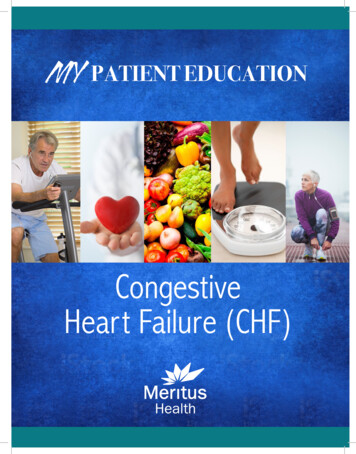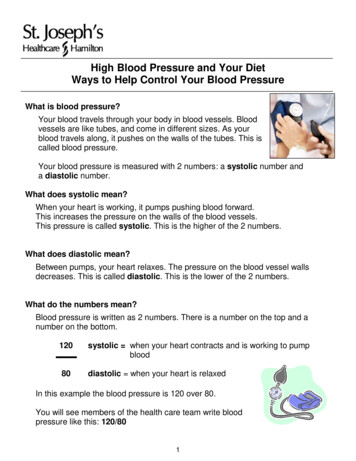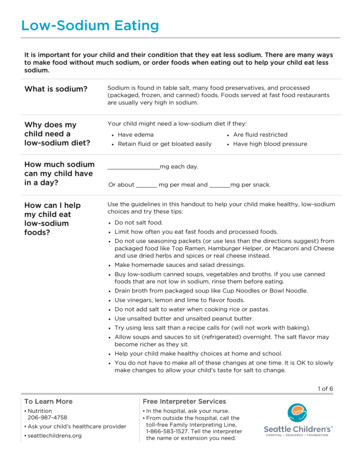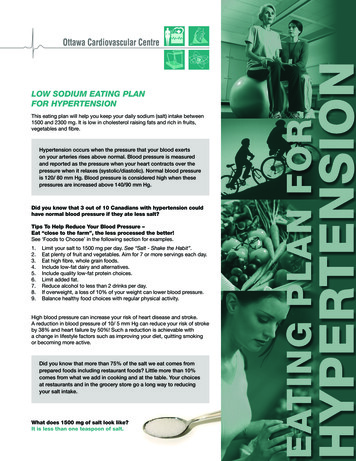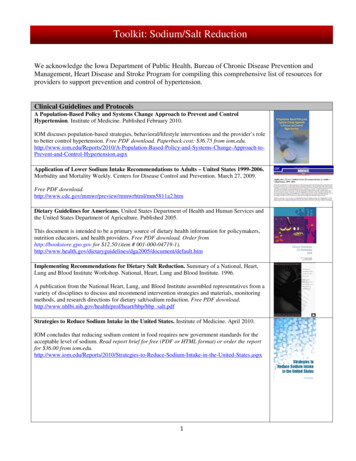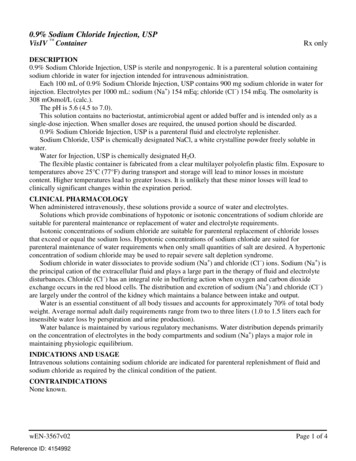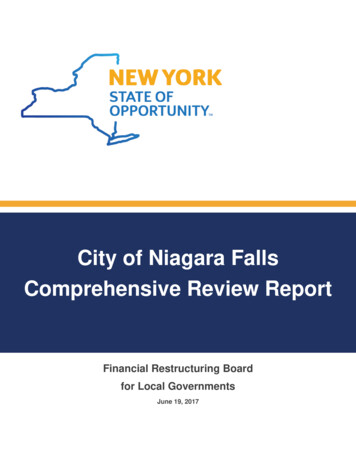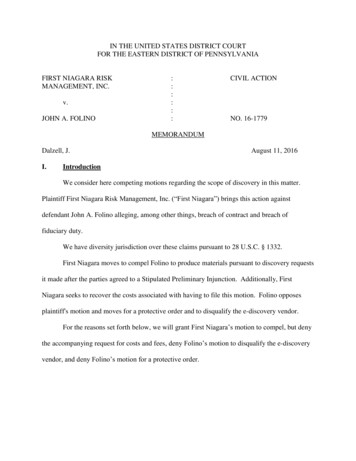
Transcription
Low sodium (salt) dietHow much sodium should I consume in a day on a low sodium diet?The average Canadian diet contains about 3400mg of sodium per day. A low sodiumdiet means limiting sodium intake to 1500 - 2300mg per day. You can use theguidelines in this education booklet to help you follow a low sodium diet.How do I limit my sodium intake?The key steps to following a low sodium diet are to:1. Limit the amount of salt and high sodium seasonings/condiments that are addedto foods at the table and during food preparation2. Limit the amount of high sodium foods in your dietLimit salt, high sodium seasonings and condimentsAdding salt or high sodium seasonings/condiments to foods at the table or during foodpreparation on a regular basis can lead to excessive sodium in our diet.Table salt, sea salt, rock salt, kosher salt and Himalayansalt are some examples of salts that are high in sodium.Common seasonings or condiments that are also high insodium include: Seasonings made with salt (e.g. garlic salt, onionsalt, lemon salt, celery salt) Soy sauce Teriyaki sauce Steak sauce Most BBQ sauces Monosodium glutamate (MSG)
The following are some tips to help reduce the amount of added salt, high sodiumseasonings and condiments in your diet.Instead of adding salt, high sodium seasonings or condiments to foods, try: adding commercial ‘salt-free’ seasoning blends to flavor food dishes duringpreparation or at the table* minced, powdered or fresh garlic during food preparation powdered or minced onion during food preparation adding lemon or lime juice to food dishes adding chopped fresh herbs, such as cilantro, oregano, rosemary or basil flavour-infused olive oils (e.g. sun dried tomato olive oil, roasted garlic olive oil) orsesame oil during food preparation dried herbs and/or spices to flavour dishes using the pepper shaker instead of the salt shaker at the table a small amount of hot sauce a dash of balsamic, red wine, or apple cider vinegar* Salt-free seasoning blends can be found in the seasoning section of the supermarket. Look for ‘Saltfree’ or ‘No salt added’ on the label. Some brands of salt-free seasonings include: Mrs. Dash,McCormick Salt-free seasonings, Clubhouse Salt-free seasonings, President’s Choice Blue Menu No SaltAdded seasonings
TIPTry making your own salt-free seasoning blendMix the following ingredients well together and store in a jar or shaker container to add flavour toyour dishes:5 teaspoons onion powder1 tablespoon paprika1 2 teaspoon pepper1 2 teaspoon celery seed1 tablespoon ground mustard1 tablespoon garlic powder1 teaspoon dried thymeLimit high sodium foodsSodium is an ingredient that is added to many food products by food companies toenhance flavor or is sometimes added as a preservative. You may not always be awareof the amount of sodium that is added to the food products you are consuming. Thissodium is often referred to as ‘hidden’ sodium, and is often the largest source ofsodium in our diet.The best way to find out how much ‘hidden’ sodium we are consuming is to look at theNutrition Facts Table. The Nutrition Facts table can be found on the label of mostpackaged food products. This table lists the amount of various nutrients that are foundin a food product, including sodium.
Example of a Nutrition Facts tableNutrition FactsServing size: ¾ cup (175g)AmountCalories 100Fat 1gSaturated 0.5g Trans 0gCholesterol 0mgSodium 670mgCarbohydrate 20gFibre 4gSugars 2gProtein 3gVitamin A0%Calcium10%% Daily value1%3%28%7%16%Vitamin C 10%Iron25%Take a look to see how much sodium is in the food products you are using. Theamount of sodium in a food product is listed in milligrams (mg) per serving.How much sodium is too much?Food products that have 200mg or less sodium per serving are considered low insodium. These are the best choices when you are trying to limit the sodium in yourdiet.Food products that have 200 - 400mg sodium per serving are considered higher insodium. It is best to use these foods in very limited amounts when following a lowsodium diet.Foods that have more than 400mg of sodium per serving are considered very high insodium. It is best to avoid these foods when following a low sodium diet.
200mg or lesssodium per serving Low sodium Best choices200 - 400mgsodium per serving Higher sodium Use in very limited amountsMore than 400mgsodium per serving Very high sodium Try to avoidUnderstanding Sodium-content Claims on a Food LabelFood companies sometimes put a claim about the salt or sodium content of a foodproduct on the food label. These claims can be used to help identify foods that arelower in sodium. The different claims that are used for sodium or salt are explainedbelow.Sodium-content claimWhat the claim it meansSalt-free or No saltLess than 5 mg sodium/servingLow salt140 mg or less of sodium/servingLower salt orReduced saltAt least 25% less sodium than the food to which it is comparedLightly saltedNo added salt(Check Nutrition Facts table to verify whether low in sodium)*At least 50% less sodium than the food to which it is compared(Check Nutrition Facts table to verify whether low in sodium)*Contains no added salt, other sodium salts or ingredients thatcontain sodium*If a food label contains a claim about salt (sodium) it is still a good idea to look at the Nutrition FactsTable to verify how much sodium(mg) is in the food product in some cases. For example, some foodproducts labelled as Lower salt, Reduced salt, and Lightly salted, may still contain higher amounts ofsodium (more than 200mg sodium/serving).
Try this ExerciseWhich of the following packages of food are low in sodium, higher in sodium, or very high in sodium.The answers are provided at the bottom of the page.Food AFood BNutrition FactsNutrition FactsServing size: ¾ cup (175g)Serving size: ¾ cup (175g)AmountCalories 100Fat 1gSaturated 0.5g Trans 0gCholesterol 0mgSodium 620mgCarbohydrate 20gFibre 4gSugars 2gProtein 3gVitamin A0%Calcium10%% Daily value1%3%28%7%16%Vitamin C 10%Iron25%Food CAmountCalories 100Fat 1gSaturated 0.5g Trans 0gCholesterol 0mgSodium 50mgCarbohydrate 20gFibre 4gSugars 2gProtein 3gVitamin A0%Calcium10%1%3%6%7%16%Vitamin C 10%Iron25%Food DNutrition FactsNutrition FactsServing size: ¾ cup (175g)Serving size: ¾ cup (175g)AmountCalories 100Fat 1gSaturated 0.5g Trans 0gCholesterol 0mgSodium 350mgCarbohydrate 20gFibre 4gSugars 2gProtein 3gVitamin A0%Calcium10%% Daily value% Daily value1%3%16%7%16%Vitamin C 10%Iron25%AmountCalories 100Fat 1gSaturated 0.5g Trans 0gCholesterol 0mgSodium 180mgCarbohydrate 20gFibre 4gSugars 2gProtein 3gVitamin A0%Calcium10%% Daily value1%3%10%7%16%Vitamin C 10%Iron25%Answer: Food A: very high sodium (more than 400mg), Food B and D: low sodium (less than 200mg), Food C: higher sodium (200-400mg)
Table of Lower and Higher Sodium FoodsThe following table lists Lower Sodium Foods (200mg or less sodium per serving) andHigher Sodium Foods (more than 200mg sodium per serving).Foods that are often very high sodium (more than 400mg per serving) are identifiedwith an Try to choose lower sodium foods, limit higher sodium foods, and avoid very highsodium foods to help maintain a low sodium dietLower Sodium FoodsVegetables- Fresh vegetables- Frozen vegetables- No salt added cannedvegetables- Low sodium vegetable ortomato juice- Low sodium cannedvegetablesFruit- Fresh fruit- Frozen fruit- Dried fruit- Canned fruit- Fruit juicesGrain Products - Whole grains (e.g. rice,quinoa, couscous, millet,barley)- Pasta and noodles- Most breads and rolls- Most dry cereals- Unsalted or low salt crackers- Unsalted or low saltbreadsticks- Most rice cakes- Cooked cereals withoutHigher Sodium Foods- Canned vegetables- Vegetable or tomato juice- Tomato or pasta sauce Pickled vegetables (e.g. pickles,sauerkraut, olives)- Most commercial pastries (e.g.donuts, muffins, croissants,danishes)- Most regular salted crackers- Instant hot cereals (e.g. instantflavoured oatmeal)- Commercial rice and pastapackaged mixes- Some breads and rolls (checklabel)- Some dry cereals (check label)
added salt (e.g. oatmeal)- Most waffles, pancakes ormixes- Some rice cakes (check label)- Some waffles, pancakes or mixes(check label)Milk and MilkAlternatives- Milk- Soy or rice beverages- Yogurt or kefir- Condensed milk- Eggnog- Sour cream- Cream cheese- Low sodium or reducedsodium cheeses (check label)- Processed cheese slices- Cheese spreads and sauces- Most commercial hot chocolatemixes- Most regular cheesesMeat andAlternatives- Fresh fish, poultry or meat- Frozen fish, poultry, meatwith no added salt- Low sodium canned fish- Dried beans and legumes(e.g. chickpeas, kidney beans,lentils)- Unsalted nuts and seeds- Peanut or other nut and seedbutters- Tofu Processed or deli meats (e.g.bacon, ham, hot dogs, cornedbeef, luncheon meats)- Most canned fish (check label)- Commercial breaded meat,poultry or fish products- Commercial meat pies- Canned baked beans- Canned beans and legumes (e.g.chickpeas, kidney beans, lentils)- Most salted nuts- Most vegetarian meat analogues(e.g. veggie burgers, sausages)Oils and Fats- Vegetable oils (e.g. olive oil, - Most commercial salad dressingscanola oil, flaxseed oil)(check label)- Some commercial salad- Most commercial dips (checkdressings (check label)label)- Some commercial dips (check - Commercial gravies or gravylabel)mixes- Margarine, butter- Mayonnaise- Homemade salad dressingswithout added salt (e.g. oiland vinegar or lemon juice)
CondimentsandSeasonings- Commercial non-saltseasonings blends (e.g. Mrs.Dash, McCormick’s)- Fresh herbs- Dried herbs- Lemon and lime juice- Vinegar- Worcestershire sauce*- Mustard*- Ketchup*- Hot pepper or chili sauce*(e.g. Tobasco)- Salsa*- Relish* Salt for seasoning (e.g. tablesalt, sea salt, kosher salt,Himalayan salt) Seasonings made with salt (e.g.garlic salt, onion salt, lemonsalt, celery salt) Soy sauce Teriyaki sauce- Steak sauce- Most BBQ sauces (check label)- Monosodium glutamate (MSG)*Use in moderation as largeamounts can contribute excesssodium to your dietSoups- Homemade broths and soups Instant soup mixes Bouillon cubeswithout added salt (or 1/10 Most commercially packagedteaspoon salt or less persoups and broths250ml serving)- Commercial soups or brothswith less than 200/mgsodium per servingOther- Homemade hamburgerswithout added salt- Homemade French frieswithout added salt (or 1/10teaspoon salt or less perserving)- Frozen or T.V. dinners withless than 600mg per meal- Snack foods without addedsalt (or 200mg or less sodiumper serving)- Fast food items such as:- French fries Hamburgers Pizzas Subs with processed meat Most Chinese food dishes Many frozen or T.V. dinners- Many salted snack foods
Common QuestionsHow long will it take for my taste buds to adjust?For many people the longer you follow a low sodium diet the more lower sodiumfoods taste more palatable and higher salt foods taste ‘too salty’. It can take a fewweeks for taste buds to start to adjust to the lower sodium diet.What about naturally occurring sodium?Many foods contain small amounts of naturally-occurring sodium (sodium naturallyfound in food). This only amounts to a small amount of sodium in our diet and doesnot need to be limited. Higher amounts of sodium in food (more than 200mg sodiumper serving) is not due to naturally occurring sodium, but rather due to sodium addedduring food processing or preparation.How do I limit sodium when eating out at a restaurant?Meals served at restaurants are often high in sodium. Here are a few tips: Choose restaurants that can accommodate special requests Select fresh foods or foods that are grilled, baked or roasted (versus processedor deep fried foods) Request menu items to be prepared with little or no salt Ask for sauces on the side (often high in sodium) Limit use of high sodium condiments Consume small portions if high sodium foods orderedRegistered Dietitian:905-378-4647 ext.HOW ARE WE DOING?You can provide feedbackor suggestions forNiagara Health ClinicalNutrition services at:www.niagarahealth.on.ca/en/clinical-nutrition
The average Canadian diet contains about 3400mg of sodium per day. A low sodium diet means limiting sodium intake to 1500 - 2300mg per day. You can use the guidelines in this education booklet to help you follow a low sodium diet. How do I limit my sodium intake? The key steps to following a low sodium diet are to: 1.
